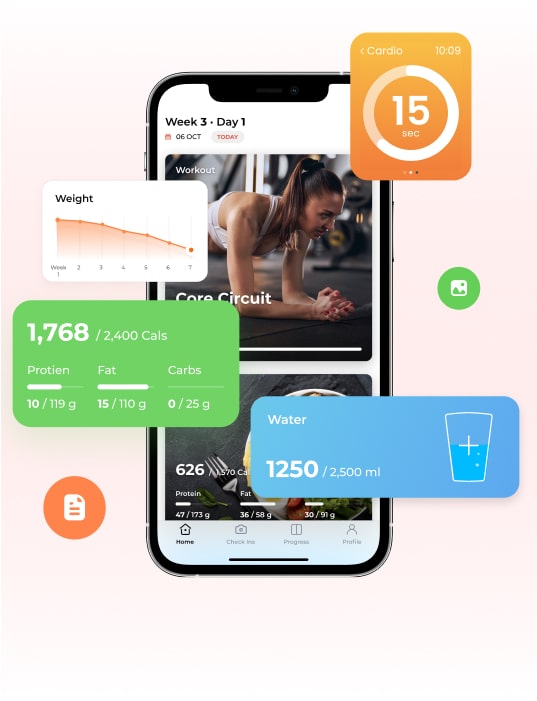Are You Earning Up to Your Potential?
Most personal trainers are undervaluing their time and skills. Our Personal trainer Revenue Calculator helps you find out what you should be making, and how to get there.
No guesswork. Just real numbers.
.jpg)
Introduction
In the dynamic fitness world, staying ahead of the curve is crucial for attracting the next wave of fitness enthusiasts – Gen Z. Born between the mid-1990s and early 2010s, Gen Z represents a demographic that values health, wellness, and unique experiences. Fitness studios looking to tap into this market need to adapt their strategies to resonate with the preferences and behaviors of Gen Z. This comprehensive guide explores vital insights and actionable tips to help fitness trainers and studio owners successfully attract Gen Z members and increase their gym memberships.
Understanding Gen Z:

Gen Z is poised to wield unparalleled influence on the fitness industry. Their age group prefers a holistic lifestyle, mental wellbeing, physical health, active lifestyle, and commitment to social causes are key elements reshaping the future of fitness studios. Recognizing and adapting to their distinct characteristics is essential for fitness professionals navigating this evolving landscape.
1. Digital Engagement:

Social Media Presence:
- Generation Z is active on social media platforms, with Instagram, TikTok, and YouTube among their favorites. Fitness studios should establish and maintain a strong presence on these platforms to reach a wider audience.
- Regularly post visually appealing content, including workout snippets, behind-the-scenes looks, success stories, and motivational content. Utilize Instagram Stories, reels, and TikTok trends to stay current and engage with the dynamic preferences of Gen Z.
Interactive Content:
- Engage Generation Z through interactive content according to fitness trends. Polls, quizzes, and challenges on platforms like Instagram and TikTok create a two-way communication channel, encouraging participation and fostering community.
- Encourage followers to share their fitness journey, challenges, and achievements, creating a user-generated content (UGC) community that showcases your fitness programs' effectiveness and builds a relatable and authentic image for your studio.
Live Streaming Workouts:
- Take advantage of live streaming to connect with Gen Z in real time. Live workout sessions, Q&A sessions with trainers, and virtual challenges enhance the sense of immediacy and engagement.
- Utilize platforms like Instagram Live or YouTube Live to conduct live workouts, allowing members to join from anywhere and fostering a sense of inclusivity.
Social Media Influencers:
- Collaborate with influencers who have a significant Generation Z following. Influencers bring authenticity and relatability to your brand, helping to establish credibility and trust.
- Influencers can create content that showcases their experiences at your fitness studio, reaching a wider audience and potentially attracting new members who identify with the influencers' values and lifestyles.
Consistent Communication:
- Maintain regular communication with your audience. Keep them informed about upcoming classes, events, and promotions through your fitness app's email newsletters, direct messages, or push notifications.
- Respond promptly to comments and direct messages on social media, demonstrating a commitment to customer engagement and building a responsive and approachable online presence.
2. Personalization and Customization:

Tailored Workout Plans:
- Provide personalized workout plans considering individual fitness goals, preferences, and health considerations. This can involve one-on-one consultations with fitness trainers to understand the unique needs of each member.
- Example: A fitness studio could offer an initial assessment session where trainers discuss goals, fitness levels, and health concerns before creating a customized workout plan.
Individualized Training Sessions:
- Offer one-on-one training sessions focusing on each member's specific needs and objectives in your health clubs. This personalized approach ensures workouts are adapted to an individual's fitness level, challenges, and preferences.
- Example: A member with specific strength training goals might benefit from personalized weightlifting sessions, while someone who prefers high-intensity interval training (HIIT) could have customized sessions in that format.
Technology-Driven Personalization:
- Leverage fitness technology to provide data-driven insights and recommendations. Wearable devices, fitness apps, and tracking tools can help members monitor their progress and receive personalized feedback.
- Example: Members could use a fitness app that tracks their daily activity, sleep patterns, and nutrition. Trainers can then use this data to offer personalized advice and adjustments to optimize their fitness journey.
Flexible Class Structures:
- Implement flexible class structures that allow members to choose the type and intensity of workouts that suit their preferences. Offering a variety of classes ensures that members can personalize their fitness routines based on their mood and fitness goals.
- Example: A fitness studio might have a weekly schedule that includes yoga, strength training, dance, and cardio classes. Members can choose the classes that align with their interests and schedule.
Nutritional Guidance:
- Include personalized nutritional guidance as part of the fitness program and health club. This could involve working with nutritionists or providing educational resources to help members make informed dietary choices based on their needs.
- Example: The fitness studio might organize nutrition workshops or offer personalized meal plans that cater to specific dietary preferences or restrictions.
💪 Got an idea for a brand? Let's bring it to life.
Launch your own fitness app with FitBudd in minutes!

💪 Got your brand name? Let’s bring it to life.
Launch your own fitness app with FitBudd in minutes!


88% trainers worldwide gave us 5 stars
Transform your fitness business with the power of your branded app on iOS and Android.
Try for FREE3.Community and Social Connection:

Personalization and Customization" is a crucial strategy for fitness studios aiming to attract Generation Z members. This generation values individuality and seeks experiences tailored to their needs and preferences. By offering personalized and customized fitness experiences, studios can create a stronger connection with Gen Z. Here's an in-depth look at this strategy, along with some examples:
Tailored Workout Plans:
- Provide personalized workout plans considering individual fitness goals, preferences, and health considerations. This can involve one-on-one consultations with fitness trainers to understand the unique needs of each member.
- Example: A fitness studio could offer an initial assessment session where trainers discuss goals, fitness levels, and health concerns before creating a customized workout plan.
Individualized Training Sessions:
- Offer one-on-one training sessions focusing on each member's specific needs and objectives. This personalized approach ensures workouts are adapted to an individual's fitness level, challenges, and preferences.
- Example: A member with specific strength training goals might benefit from personalized weightlifting sessions, while someone who prefers high-intensity interval training (HIIT) could have customized sessions in that format.
Technology-Driven Personalization:
- Leverage fitness technology to provide data-driven insights and recommendations for Gen Z Fitness. Wearable devices, fitness apps, and tracking tools can help members monitor their progress and receive personalized feedback.
- Example: Members could use a fitness app that tracks their daily activity, sleep patterns, and nutrition. Trainers can then use this data to offer personalized advice and adjustments to optimize their fitness journey.
Flexible Class Structures:
- Implement flexible class structures that allow members to choose the type and intensity of workouts that suit their preferences. Offering a variety of classes ensures that members can personalize their fitness routines based on their mood and fitness goals.
- Example: A fitness studio might have a weekly schedule that includes yoga, strength training, dance, and cardio classes. Members can choose the classes that align with their interests and schedule.
Nutritional Guidance:
- Include personalized nutritional guidance as part of the fitness program. This could involve working with nutritionists or providing educational resources to help members make informed dietary choices based on their needs.
- Example: The fitness studio might organize nutrition workshops or offer personalized meal plans that cater to specific dietary preferences or restrictions.
Progress Tracking and Celebrations:
- Implement a system for tracking members' progress and celebrating their achievements. Recognizing and acknowledging individual milestones fosters a sense of accomplishment and motivation.
- Example: Create a recognition board in the studio or on social media platforms to celebrate members who have achieved specific fitness milestones, whether weight loss, improved endurance, or mastering a challenging exercise.
Adapting Fitness Programs:

4.Diverse and Inclusive Classes:
This is a crucial strategy for fitness studios to attract Generation Z members. This generation values diversity and inclusivity, seeking experiences catering to various interests and backgrounds. To create a welcoming and accessible environment, fitness studios should offer a variety of classes that address different fitness levels, preferences, and cultural backgrounds. Here's a detailed explanation of this strategy, along with examples:
Varied Workout Formats:
- Provide a diverse range of workout formats to accommodate different preferences. This can include high-intensity interval training (HIIT), yoga, dance, strength training, cardio, and more.
- Example: Schedule a mix of weekly classes, such as a high-energy dance workout on Mondays, a calming yoga session on Wednesdays, and a strength-training class on Fridays. This ensures there's something for everyone.
Inclusive Instructors and Trainers:
- Ensure that your team of instructors reflects diversity. Inclusive representation among trainers helps create a welcoming atmosphere and allows members to identify with their instructors.
- Example: Recruit instructors from various backgrounds, ethnicities, and genders. This brings diverse expertise to your studio and fosters a sense of representation for all members.
Adapted Workouts for All Levels:
- Modify workouts to cater to different fitness levels. Offer options for beginners, intermediate, and advanced participants within the same class to accommodate a diverse range of abilities.
- Example: During a strength training class, instructors can provide variations for each exercise, making it accessible for beginners while challenging for those with more advanced fitness levels.
Culturally Inclusive Programming:
- Introduce classes and programming that celebrate various cultural influences. This can include dance classes inspired by different cultures or themed workout events that embrace diversity.
- Example: Host a monthly "Global Groove" dance class incorporating dance styles worldwide. This not only diversifies your class offerings but also celebrates cultural richness.
Accessible Facilities:
- Ensure that your fitness studio is physically accessible to individuals with different abilities. This may involve providing ramps, accessible restrooms, and equipment suitable for various needs.
- Example: Install fitness equipment that accommodates individuals with mobility challenges and communicate the accessibility features of your studio to encourage a diverse clientele.
5.Tech-Integrated Workouts:
Gen Z, a tech-savvy generation, is drawn to innovative and interactive approaches to fitness. Fitness studios that leverage technology can attract and engage Gen Z members by offering a modern and dynamic workout environment. Here's a breakdown of this strategy with relevant examples:
Virtual Reality (VR) Workouts:
%20Workouts-min.jpg)
- Introduce virtual reality elements to workouts, providing an immersive experience. VR workouts can transport members to different environments, making exercise more engaging and enjoyable.
- Example: Develop VR fitness programs that simulate outdoor running trails, underwater environments for swimming workouts, or virtual fitness classes in unique settings.
Fitness Apps and Wearables:
- Encourage using fitness apps and wearables that track and analyze workout data. These tools provide real-time feedback, personalized recommendations, and progress tracking.
- Example: Partner with a fitness app that offers guided workouts, nutrition tracking, and social features. Members can sync their app data with the studio's system, allowing trainers to provide tailored advice.
Interactive Equipment:
- Invest in interactive fitness equipment that combines physical activity with digital interfaces. This can include intelligent treadmills, augmented reality (AR) mirrors, and equipment that syncs with gaming consoles.
- Example: Incorporate innovative treadmills with interactive screens that simulate different terrains. Members can virtually run through cityscapes or participate in competitive races against others.
Live Streaming and On-Demand Classes:

- Provide live streaming options for members who prefer working out from home or joining classes remotely. Additionally, offers on-demand courses that members can access at their convenience.
- Example: Use platforms like Zoom or dedicated fitness streaming services to broadcast live classes. Record these sessions for on-demand access, allowing members to follow their favorite workouts on their schedules.
Biometric Monitoring:
- Utilize biometric monitoring tools to track members' vital signs and performance metrics during workouts. This data can help customize workout plans and assess the effectiveness of fitness programs.
- Example: Integrate heart rate monitors, smart scales, or other biometric devices into workouts. Trainers can use the collected data to optimize training intensity and offer personalized recommendations.
Gamification of Fitness:
- Gamify workouts by incorporating elements of competition, rewards, and challenges. This approach can make fitness more enjoyable and motivate Gen Z members to stay consistent with their exercise routines.
- Example: Create fitness challenges with leaderboards, badges, and rewards for achieving milestones. Members can compete with each other or collaborate to achieve shared goals, fostering a sense of community.
Augmented Reality (AR) Workouts:
- Implement augmented reality features that overlay digital elements onto the real-world environment. AR workouts can provide interactive guidance and visual cues during exercises.
- Example: Develop AR fitness apps that project workout instructions onto the studio floor or use AR glasses to provide real-time feedback on form and technique during exercises.
Marketing Strategies:
6. Authentic Branding:
- Gen Z values authenticity. Craft a genuine, transparent brand image that aligns with your fitness studio's values
- Highlight real stories and testimonials from Gen Z members to build trust and credibility.
7. Social Media Influencers:
- Collaborate with fitness influencers popular among Gen Z. Influencers can help amplify your studio's reach and connect with a broader audience.
- Encourage influencers to share their experiences at your studio, creating a buzz among their followers.
Creating an Experience:
8. Aesthetically Pleasing Environment:
- Pay attention to the aesthetics of your studio. Gen Z is drawn to visually appealing spaces.
- Invest in modern, Instagram-worthy interior designs that encourage members to share their experiences on social media.
9. Gamification of Fitness:
- Introduce gamified elements to workouts. Incorporate challenges, leaderboards, and rewards to make fitness more engaging and competitive.
- Consider partnering with fitness apps that offer gamification features to attract Gen Z & previous generations members seeking a fun and interactive fitness experience.
Conclusion:
Adapting and embracing their values, preferences, and behaviors is essential to attracting Gen Z members to your fitness studio. By leveraging digital engagement, personalization, community building, diverse fitness programs, and innovative marketing strategies, fitness trainers and studio owners can position themselves as attractive destinations for the next generation of fitness enthusiasts. Remember, the fundamental lies in creating an experience beyond traditional workouts, providing Gen Z with a holistic and engaging approach to health and wellness and mental health.
Frequently Asked Questions

Ultimate Marketing Guide for Fitness Trainers
Boost your business growth with these tried and tested marketing strategies. Free for you to download.
Download Now
Templates
These functional templates have the power to make any fitness trainer's life easier.
Subscribe To
Our Blog




























